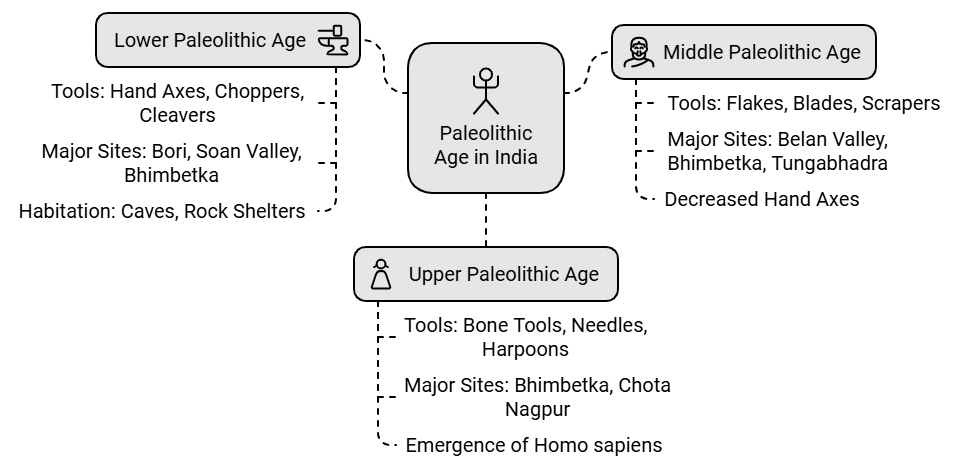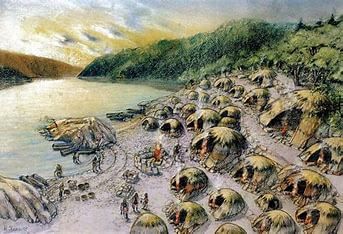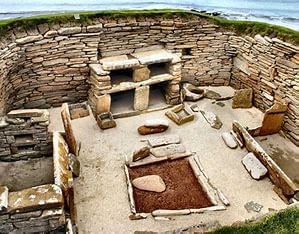Pre-historic Period | History for UPSC CSE PDF Download
Introduction
- The earliest known evidence of man in our country was in Bori in Maharashtra and dates back to 1.4 million years ago
- Prehistory is the period that has records of human activities, civilization, using of stone tools. This period doesn’t witness any writings from the civilians, therefore, this period is the prehistoric period in Ancient history.
- Prehistory also refers to the hunter-gatherer lifestyle of people in that era/ period. Pre-history is the fact of origin of human activities and civilization thousands of years ago. In general, prehistory is divided into 3 ages and hence the name was given "A 3 Age System".
- The 3 ages are: the Stone Age, Bronze Age, and Iron Age.
These 3 ages give pieces of evidence of human activity in ancient times. These ages are evolutionary ages in humankind.
Stone Age
 Stone Age
Stone Age
- The stone age is the prehistoric period, i.e., the period before the development of the script, therefore the main source of information for this period is the archaeological excavations. Robert Bruce Foote is the archaeologist who discovered the first palaeolithic tool in India, the Pallavaram handaxe.
- On the basis of geological age, the type and technology of stone tools, and subsistence base, the stone age is classified primarily into three types:
- Paleolithic Period (2 million BC – 10,000 BC)
- Mesolithic Period (10,000 BC – 8000 BC)
- Neolithic Period (8000 BC – 4000 BC)
- Chalcolithic Period (4000 BC – 1500 BC)
- Iron Age (1500 BC – 200 BC)

The Palaeolithic Age (2 million BC – 10,000 BC)
- The term ‘Palaeolithic’ is derived from the Greek word ‘paleo' which means old and ‘lithic’ meaning stone. Therefore, the term Palaeolithic age refers to the old stone age.
- The Old Stone Age or paleolithic culture of India developed in the Pleistocene period or the Ice Age, which is a geological period of the age when the earth was covered with ice and the weather was so cold that human or plant life could not survive. But in the tropical region, where ice melted, the earliest species of men could exist.
 Living in Paleolithic Age
Living in Paleolithic Age
Main characteristics of the Palaeolithic age:
- The Indian people are believed to have belonged to the ‘Negrito’ race, and lived in the open air, river valleys, caves and rock shelters.
- They were food gatherers, ate wild fruits and vegetables, and lived on hunting.
- There was no knowledge of houses, pottery, agriculture. It was only in later stages they discovered fire.
- In the upper paleolithic age, there is evidence of art in the form of paintings.
- Humans used unpolished, rough stones like hand axes, choppers, blades, burins and scrapers.
The old stone age or paleolithic age in India is divided into three phases according to the nature of the stone tools used by the people and also according to the nature of the change of climate.
(a) Lower Palaeolithic Age ( up to 100,000 BC)
- It covers the greater part of the Ice Age.
- Hunters and food gatherers; tools used were hand axes, choppers and cleavers. Tools were rough and heavy.
- One of the earliest lower Palaeolithic sites is Bori in Maharashtra.
- Limestone was also used to make tools.
- Major sites of lower Palaeolithic age: Soan valley (in present Pakistan), Sites in the Thar Desert, Kashmir, Mewar plains, Saurashtra, Gujarat,Central India,Deccan Plateau, Chotanagpur plateau, North of the Cauvery River, Belan valley in UP
- There are habitation sites including caves and rock shelters.
- An important place is Bhimbetka in Madhya Pradesh.
(b) Middle Palaeolithic Age ( 100,000 BC – 40,000 BC)
- Tools used were flakes, blades, pointers, scrapers and borers.
- The tools were smaller, lighter and thinner.
- There was a decrease in the use of hand axes with respect to other tools.
- Important middle Palaeolithic age sites: Belan valley in UP, Luni valley (Rajasthan), Son and Narmada rivers, Bhimbetka, Tungabhadra river valleys, Potwar Plateau (between Indus & Jhelum), Sanghao cave (near Peshawar, Pakistan)
(c) Upper Palaeolithic Age (40,000 BC – 10,000 BC)
- The upper palaeolithic age coincided with the last phase of the ice age when the climate became comparatively warmer and less humid.
- The emergence of Homo sapiens.
- The period is marked by innovation in tools and technology. A lot of bone tools, including needles, harpoons, parallel-sided blades, fishing tools and burin tools.
- One of the major sites were Bhimbhetka (South of Bhopal), where hand axes and cleavers, blades, scrapers and a few burins have been found.
- Major sites of Upper Palaeolithic age: Belan, Son, Chota Nagpur plateau (Bihar), Maharashtra, Orissa and The Eastern Ghats in Andhra Pradesh
- Bone tools have been found only at cave sites of Kurnool and Muchchatla Chintamani Gavi in Andhra Pradesh.
Which of the above statement(s) is/are correct?
1. These sites are generally located near water sources.
2. Some of these sites were near the places where the stone was easily available and where the people could make stone implements.
3. Most of these sites are concentrated in Southern India with the exception of Siwalik Hills and Bhimbetka.
The Mesolithic Age (10,000 BC – 8000 BC)
- The term Mesolithic is derived from two Greek words – ‘meso’ and ‘lithic’. In Greek ‘meso’ means middle and ‘lithic’ means stone. Hence, the Mesolithic stage of prehistory is also known as the ‘Middle Stone Age’.
- Both Mesolithic and Neolithic phases belong to the Holocene era. In this era, there was a rise in temperature, the climate became warm which resulted in melting of ice and also brought changes in flora and fauna.
 Mesolithic age group people
Mesolithic age group people
Characteristic Features of the Mesolithic Era
- Mesolithic Age: Transitional phase between Paleolithic and Neolithic Ages.
- Hunting, fishing, food gathering: Primary means of subsistence.
- Microliths: Characteristic tools made of materials like chalcedony or chert.
- Clothing made from animal skins: Emergence of early clothing.
- First human colonization of the Ganga Plains: Expansion of human habitation.
- Belief in life after death: Influence on burial customs.
- Mesolithic sites: Abundant in various regions, e.g., Rajasthan, southern Uttar Pradesh.
- Early plant cultivation: Evidence around 7000-6000 B.C., particularly in Rajasthan.
- Prehistoric art, including paintings: Notable at Bhimbetka in Madhya Pradesh.
- Perching birds: Absence in earliest paintings, reflecting hunting/gathering lifestyle.
Important Mesolithic Sites
 Mesolithic Sites
Mesolithic Sites
- Bagor in Rajasthan is one of the biggest and best-documented Mesolithic sites in India. Bagor is on river Kothari where microliths along with animal bones and shells have been excavated.
- Adamgarh in Madhya Pradesh provides the earliest evidence for the domestication of animals.
- There are about 150 Mesolithic rock art sites across India, with a rich concentration in Central India such as Bhimbetka caves (Madhya Pradesh), Kharwar, Jaora and Kathotia (M.P), Sundargarh and Sambalpur (Odisha), Ezhuthu Guha (Kerala).
- Microliths have also been found in some valleys of river Tapi, Sabarmati, Narmada, and Mahi.
- Langhnaj in Gujarat and Biharanpur in West Bengal are also important Mesolithic sites. Bones of wild animals (rhinoceros, blackbuck, etc.) have been excavated from Langhnaj. Several human skeletons and a large number of microliths have been recovered from these places.
- Though pottery is absent at most Mesolithic sites, it has been found in Langhnaj (Gujarat) and in the Kaimur region of Mirzapur (U.P).
1. The use of larger stones as tools was the characteristic feature 2. Smaller animals were hunted in general Select from the following codes
The Neolithic Age (8000 BC – 4000 BC)
- Neolithic Age: Globally began around 9000 B.C.
- Neolithic Revolution: Introduction of agriculture, shifting from hunter-gatherer to food producer.
- Neolithic phase in south India: Estimated from 2000 B.C. to 1000 B.C.
- Earliest farming communities: Emerged during this period.
- Tools: Stone hoes and digging sticks used for cultivation.
- Ring stones: Attached to tools for improved efficiency in farming.
- Primary crops: Ragi (finger millet) and horse gram (kulathi) cultivated.
- Mehrgarh: Advanced Neolithic society in the Indian subcontinent.
- Crops: Wheat and cotton cultivated.
- Housing: Mud-brick houses used.
- Significance: Transition to agriculture led to social, economic, and technological advancements.
 Neolithic Age
Neolithic Age
Characteristic Features of the Neolithic Age
- Tools and Weapons: Microlithic blades and polished stone tools were used, along with celts for ground and polished hand axes. Bone tools such as needles, scrapers, borers, and arrowheads were also common, aiding in various activities including cultivation and hunting.
- Agriculture: Neolithic people cultivated land, growing crops like ragi and horse gram, and domesticated cattle, sheep, and goats.
- Pottery: Pottery emerged on a large scale for storing and cooking food. Types included greyware, black-burnished ware, and mat impressed ware, initially handmade but later made using foot wheels.
- Housing and Settled Life: Neolithic people lived in mud and reed houses, leading a more settled life. They also developed skills in boat making and textile production, spinning cotton, wool, and weaving cloth.
- Settlement Patterns: Neolithic settlements were mainly located in hilly river valleys, rock shelters, and hillsides, relying on stone tools and weapons.
- Technological Progress: Between 9000 B.C. and 3000 B.C., remarkable technological progress occurred in western Asia, including cultivation, weaving, pottery, house building, and animal domestication. However, the Neolithic Age in the Indian subcontinent began around the sixth millennium B.C.
- Types of Axes and Settlement Areas: Three main types of axes characterized Neolithic settlements:
- Northwestern group: Rectangular axes with curved cutting edges.
- Northeastern group: Polished stone axes with rectangular butts, occasionally with shouldered hoes.
- Southern group: Axes with oval sides and pointed butts.
Important Neolithic Sites:
 Neolithic Sites
Neolithic Sites
- Koldihwa and Mahagara (south of Allahabad): Circular huts, handmade pottery, evidence of rice cultivation.
- Mehrgarh (Balochistan, Pakistan): Sun-dried brick houses, cultivation of cotton and wheat.
- Burzahom (Kashmir): Pit dwellings, burial of domestic dogs with masters, use of polished stone and bone tools.
- Gufkral (Kashmir): Pit dwellings, stone tools, graveyards within houses.
- Chirand (Bihar): Use of bone tools and weapons.
- Piklihal, Brahmagiri, Maski, Takkalakota, Hallur (Karnataka): Cattle herding, domestication of sheep and goats, discovery of ash mounds.
- Belan Valley (northern spurs of Vindhyas and middle part of Narmada valley): Sequence of paleolithic, mesolithic, and neolithic ages.
- Garo hills (Meghalaya): Neolithic tools found on the northeastern frontier.
- Orissa and Chotanagpur hill areas: Discovery of neolithic celts, axes, adzes, chisels, etc.
Chalcolithic Period (4000 BC – 1500 BC)
Also known as the Copper Age, it marks the transition between the Neolithic and Bronze Ages, characterized by the use of both copper and stone tools.
 Chalcolithic Period
Chalcolithic Period
- Metal Use: Copper was utilized alongside stone for tool making, marking a significant advancement in technology and metallurgy.
- Emergence of Metallurgy: Chalcolithic communities began to smelt copper ore and produce copper tools and artifacts, indicating the development of metallurgical skills.
- Continued Agriculture: Agriculture remained a key economic activity, with the cultivation of crops such as wheat, barley, and millets continuing from the Neolithic period.
- Settlement Patterns: Communities were mostly settled, engaging in agriculture, animal husbandry, and craft production.
- Trade Networks: With the advent of metal tools, trade networks expanded, facilitating the exchange of goods over wider regions.
- Craft Specialization: The Chalcolithic period saw the emergence of craft specialization, with artisans producing pottery, metal tools, and other artifacts for trade and local use.
- Artistic Expression: Artistic expression flourished, with pottery featuring intricate designs and motifs, reflecting the cultural and social developments of the period.
- Burial Customs: Burial customs varied, with some communities practicing cremation while others engaged in burial with grave goods, reflecting diverse cultural practices.
- Regional Variations: The Chalcolithic period exhibited regional variations in material culture, settlement patterns, and technological advancements, reflecting the diversity of human societies during this time.
Sites:
 Chalcolithic Sites
Chalcolithic Sites
- Harappa: In the Indus Valley, Harappa was a significant Chalcolithic site, exhibiting evidence of metallurgy and urban planning.
- Mohenjo-Daro: Another major Indus Valley site, Mohenjo-Daro, showed evidence of advanced urbanization, craft specialization, and trade networks during the Chalcolithic period.
- Banawali: Located in Haryana, India, Banawali is an important Chalcolithic site known for its well-planned settlement, advanced drainage system, and evidence of copper smelting.
- Ganeshwar: In Rajasthan, India, Ganeshwar is notable for its copper artifacts, including tools and ornaments, indicating early metallurgical activities.
- Ghaligai: Located in Balochistan, Pakistan, Ghaligai is an early Chalcolithic site known for its distinctive pottery and evidence of copper metallurgy.
- Ahar-Banas Culture: Found in Rajasthan, India, this culture is associated with the Chalcolithic period and is known for its distinctive pottery styles and copper artifacts.
- Mehrgarh: Continuously inhabited from the Neolithic to the Chalcolithic period, Mehrgarh in Pakistan provides valuable insights into the transition from stone to copper tools and early urbanization.
Iron Age (1500 BC – 200 BC)
The Iron Age marks a significant technological advancement with the widespread use of iron tools and weapons, replacing bronze and copper.
 Iron Age
Iron Age
- Metallurgical Revolution: The discovery and utilization of iron ore for making tools and weapons revolutionized human societies, leading to significant changes in warfare, agriculture, and craftsmanship.
- Iron Smelting: Iron smelting techniques were developed, allowing for the extraction of iron from ore and its subsequent shaping into tools and weapons through forging and casting.
- Impact on Warfare: The availability of iron weapons, such as swords, spears, and armor, transformed military tactics and warfare, leading to the rise of powerful empires and states.
- Agricultural Advancements: Iron tools, such as plows and sickles, improved agricultural productivity, enabling the cultivation of larger areas of land and the production of surplus food.
- Urbanization: The Iron Age witnessed the growth of urban centers and the emergence of complex societies, with centralized governance, specialized labor, and trade networks.
- Artistic and Cultural Developments: Iron Age societies produced elaborate artistic works, including sculpture, pottery, and metalwork, reflecting cultural diversity and social complexity.
- Trade and Exchange: Trade networks expanded, facilitating the exchange of goods, ideas, and technologies over vast distances, promoting cultural diffusion and economic growth.
- Burial Practices: Burial customs varied across different regions and cultures, with some societies practicing elaborate burial rituals and constructing monumental tombs for the elite.
- Decline and Transition: Towards the end of the Iron Age, the rise of new empires and the introduction of new technologies, such as coinage and writing, paved the way for the transition to the subsequent historical period.
|
216 videos|855 docs|219 tests
|
FAQs on Pre-historic Period - History for UPSC CSE
| 1. What are the main characteristics of the Palaeolithic Age? |  |
| 2. How did the Mesolithic Age differ from the Palaeolithic Age? |  |
| 3. What were the significant changes during the Neolithic Age? |  |
| 4. What is the Chalcolithic Period and what advancements occurred during this time? |  |
| 5. How did the Iron Age impact human civilization? |  |






















